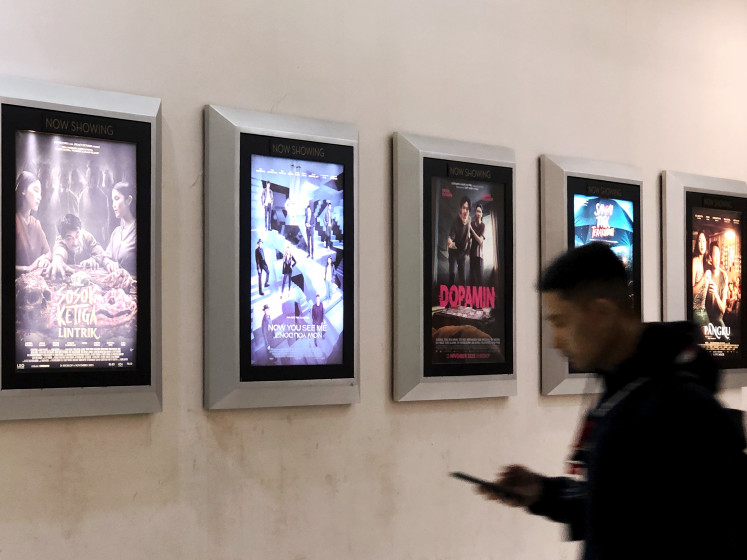Popular Reads
Top Results
Can't find what you're looking for?
View all search resultsPopular Reads
Top Results
Can't find what you're looking for?
View all search resultsXu Bing: Putting spotlight on social issues through art
Signature piece: Xu Bing’s Book from the Sky mixed media installation is displayed at his solo exhibition “Xu Bing: Thought and Method” at the Museum of Modern and Contemporary Art in Nusantara (Museum MACAN) in Jakarta, his first solo exhibition in Southeast Asia
Change text size
Gift Premium Articles
to Anyone
S
ignature piece: Xu Bing’s Book from the Sky mixed media installation is displayed at his solo exhibition “Xu Bing: Thought and Method” at the Museum of Modern and Contemporary Art in Nusantara (Museum MACAN) in Jakarta, his first solo exhibition in Southeast Asia. (Courtesy of UCCA/Museum MACAN)
For Chinese artist Xu Bing, art is not merely seen through an aesthetic lens, but also what it means for a society: a reflection of social ills.
“The inspiration does not come from the local problems in China, but more from global issues. Even though I come from China and I have a very strong background in Chinese culture, I have lived in and visited many countries so I think my view is more global,” he told The Jakarta Post through an interpreter.
“So where you live, there will be problems. Where there are problems, there’s art.”
Xu was in town as part of his solo exhibition “Xu Bing: Thought and Method” at the Museum of Modern and Contemporary Art in Nusantara (Museum MACAN). Being held until Jan. 20 next year, the exhibition is Xu’s first solo exhibition in Southeast Asia, featuring 60 artworks created over a span of 40 years.
Born in Chongqing in 1955 to academic parents, Xu moved to Beijing in 1956 where he grew up on the Peking University campus, where his father was head of the history department.
Xu was exposed to the arts from a young age, yet turbulent times were brewing as the Cultural Revolution was launched in China in 1966. When he started middle school in 1968, Xu became an unpaid instructor teaching art to his peers, as the school had no art teachers.
Perhaps his most well-known installation is Book from the Sky, a 604-page book spanning four volumes filled with 4,000 characters that resemble Chinese characters, but are ultimately meaningless.
Each character was painstakingly carved into individual pieces of movable type, taking inspiration from typefaces of the Song and Ming dynasties.
First exhibited in 1988, Book from the Sky received a mixed to favorable reception from critics, but received close scrutiny from the government after the 1989 Tiananmen Square protests.
Like many other artists in this era, Xu eventually left for the United States in 1991, where he stayed for 18 years before returning to Beijing.
The artist: Xu Bing’s Jakarta exhibition marks his first solo exhibition in Southeast Asia, featuring 60 artworks created over a span of 40 years. (Courtesy of Museum MACAN)Xu’s artworks tend to tackle various social issues that might find relevance wherever they are exhibited.
For example, Honor and Splendor depicts a giant tiger skin rug entirely composed of 660,000 cigarettes, juxtaposing the inherent dangers of tobacco and tigers with imagery of wealth and desire.
The Tobacco Project, of which Honor and Splendor is a part, began with an invitation by Duke University. Xu said that Durham, where the university is located, had a rich history of tobacco related to the Duke family.
“This is an example of a non-Chinese inspiration. We undertook very in-depth research on the history of tobacco and the city, and we realized the history could be traced much further, with trade between China and the US in opium and tobacco.”
Xu said he was very sensitive to social problems, something he became attuned to by simply being aware and observant of the causes.
“I think it’s a waste of time if you repeat someone else’s words and thoughts. If you want to say something new in a very effective way, you have to find a new approach or way of telling it, and only in that way can others hear your voice.
“The new way of telling a story is the new approach for artists to create art. As an artist, when I think of art,
I don’t start from the material or style; I start from the social problems that concern humanity,” he said.
However, Xu continues, artists cannot dwell on the social problems alone, they should also think of a way to express their thoughts.
“The mission for artists is not only to highlight the problems. The goal for artists is really the final step of creating art that reflects the social problems.”
Many of Xu’s artworks are instilled with messages that viewers might not see on first viewing.
Xu Bing’s Square Word Calligraphy Classroom (Courtesy of UCCA/Museum MACAN)Consider the Background Story installation, which at first glance is reminiscent of East Asian scroll paintings depicting landscapes on a glass surface. But when visitors walk behind the wall, they see all the hidden mess of twigs and masking tape that ultimately composes a beautiful image.
Then there’s the rather graphic A Case Study of Transference, which in its initial performance in Beijing in 1993 involved two live pigs that started mating in front of the audience. This juxtaposes the discomfort of humans and their civilizations when faced with the most primal urges of living beings.
Xu said viewers should be able to draw their own conclusions about the messages of the artworks, and that he never instilled a strict point of view in his art.
Returning to the Tobacco Project, the central problem is not tobacco itself, he says, but rather the relationship between human and tobacco.
“So the work is really to review the problems of humankind, but we use tobacco as the material to pinpoint the problem. A lot of interpretations can be applied to the work, so in my creation, the work also reviews the economic side of the global trade,” Xu said, noting that the project also reflected history.
Xu points to a work in the Tobacco Project titled Prophecy, which comprises different receipts of a century-old tobacco trade between America and China. One of the receipts spells out how Trinity College, which would later become Duke University, benefited from the Chinese profits from the trade.
“When I created the work, Duke University paid me an artist’s fee for the project, and I added this receipt; the amount of money. I just want to make them match, because in the past China paid the US tobacco, but now a US university is paying me to make an artwork reflecting on the history.
“I think one important message is if y ou want to see the essence of something, you have to depoliticize it. We give too much political influence for tobacco, but it’s just a plant, without all the innuendo of political messages.” (ste)

.img_assist_custom-780x385.jpg)
.img_assist_custom-780x525.jpg)









